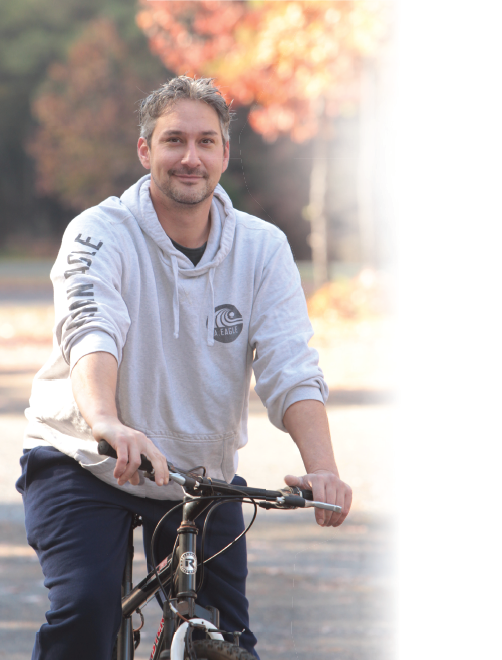“I’m a veteran of three other big spine surgeries, but this is the most life-altering of all of them ... I couldn’t be happier”

The innovative “awake spinal fusion” procedure puts patients back in action faster.
I had 20 years of back pain that got progressively worse over a short period of time,” says Jordan Feinman, 41, of Old Bridge Township. His condition affected his job as a union electrician, which requires working with a team to manually move two-ton spools of construction cable. At home, he began missing out on activities with his two busy daughters, ages 9 and 11.
Jordan’s pain was the result of spondylolisthesis, a condition in which vertebrae (the series of bones that make up the spine) slip out of place and put pressure on nerves. “The pain became excruciating over about 18 months,” he says. “By July of 2020, even after physical therapy and steroid injections, I could hardly walk.”

His physician referred him to Alok Sharan, MD, an orthopedic spine surgeon at Clara Maass Medical Center. That’s when he learned about a new type of minimally invasive surgery called awake spinal fusion, which was pioneered by Dr. Sharan.
“Dr. Sharan explained the new procedure, and I was ready to have it,” Jordan says. “After surgery, I got relief within hours. I went home the same day.”
Local Anesthesia
During spinal fusion surgery, a surgeon permanently connects—or fuses—two or more vertebrae. This keeps these bones from moving in ways that can cause debilitating pain like Jordan had.
The new awake spinal fusion technique achieves that goal, but with significant differences from traditional spinal fusion surgery.
Most importantly, the traditional method requires general anesthesia, which can have side effects that include nausea, vomiting or even delirium.
“For the awake procedure, we use new types of anesthetics that block the pain only where we need to, in the back, instead of putting the entire body to sleep,” Dr. Sharan explains.
As a result, patients are either awake or in a kind of “twilight” sleep during the procedure, while feeling no pain. They wake up easily when the anesthesiologist adjusts the medicine. Spinal anesthesia makes spine surgery an option for more patients, such as those whose age or other conditions put them more at risk for side effects of general anesthesia.
Awake spinal surgery has been used for years for a laminectomy, surgery to reduce back pain by reducing pressure on the spinal cord. Dr. Sharan adapted the procedure five years ago to apply to spinal fusions.
“Awake procedures had such great benefits for laminectomy patients, and I wanted my spinal fusion patients to have the same benefits,” he explains.
Pain Management
Awake spinal fusion allows for better pain control post-surgery.
“The medicines we use during the procedure can provide pain relief for up to three days,” Dr. Sharan explains. “For this procedure, we also use smaller incisions—about one to two inches— in the back to reach the spine, compared to the incisions that are needed for traditional spinal fusion surgery. That means there is less damage to the muscles and also less pain after surgery.”
Because there’s less pain post-surgery, there’s a reduced risk of becoming addicted to the strong narcotic medicines typically used to control pain after major spinal surgery. Research shows that with awake spinal surgery, seven out of 10 patients are off narcotics one week after surgery. With traditional spine surgery, nine out of 10 patients are still using narcotics up to six weeks after surgery.
No More Pain
“Before surgery, it felt like a lightning bolt shooting up my leg,” Jordan says. “I braced for it every time, and grimaced with every move.”
But just five days after surgery and free of the pain he’d lived through for two decades, he was off all pain medicines. “Even Dr. Sharan was surprised by that,” he says.
Today, Jordan no longer needs the nine over-the-counter pain pills he used to take every day just so he could go to work. He’s ready to teach his girls how to dive and to get back up on the roof with them to watch the stars.
“I’m a veteran of three other big spine surgeries, but this is the most life-altering of all of them,” Jordan says. “Clara Maass is truly a wonderful hospital. I couldn’t be happier with Dr. Sharan and every single person there.”
Dr. Sharan has performed 130 awake spinal fusions. He has also trained other surgeons and presented his research at a national conference of spine surgeons.
“The results overall have been remarkable,” Dr. Sharan says. “It’s a better way to do spine surgery.”
To learn more about awake spinal fusion at Clara Maass Medical Center, call (973) 450-2000.